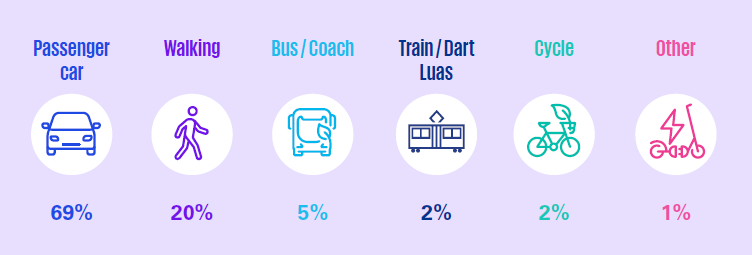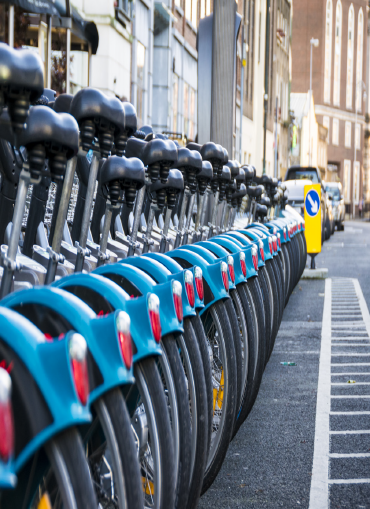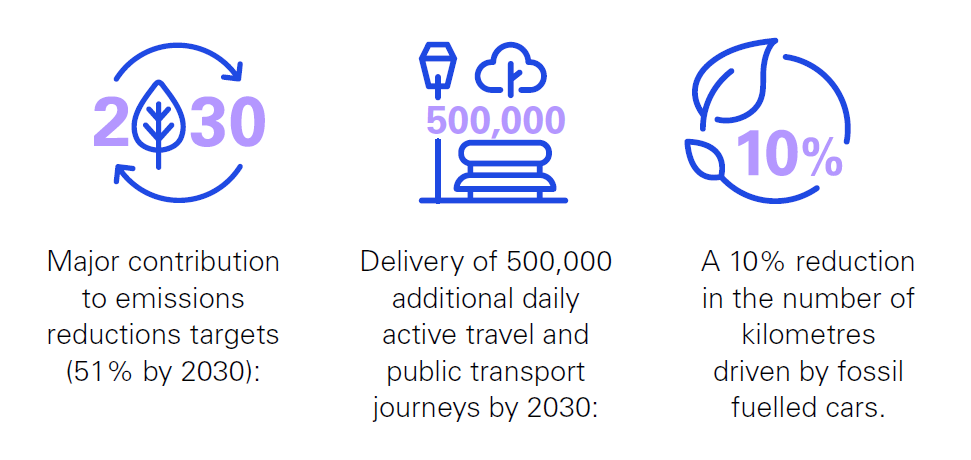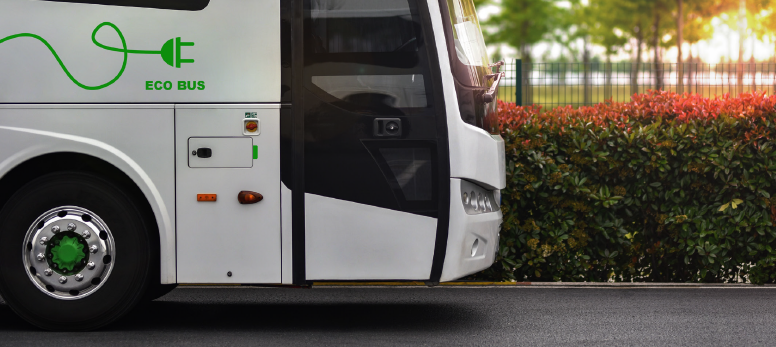Sustainable Urban Mobility (SUM) is indispensable to metropolitan decarbonisation goals and quality of life. Our Strategy and Future Analytics teams outline the concept and its implications below.
What is Sustainable Urban Mobility?
Against a backdrop of growing urbanisation, congestion, and near ubiquitous net zero commitments, policymakers and urban leaders are under pressure to modernise transport systems to drive efficiencies and to reduce greenhouse gas (GHG) emissions.
Sustainable Urban Mobility (SUM) is the concept that captures this aspiration, referring to a desired state of more low-impact transport modes and reduced dependence on high-impact ones.
SUM frameworks vary significantly from city to city, but share an emphasis on public transport, Mobility-as-a-Service (MaaS), Intelligent Transport Systems (ITS), active mobility modes such as walking and cycling, zero-emission logistics, and vehicle sharing, as well as multimodal optimisation via digital platforms and multimodal hubs.
SUM is grounded in a range of foundational technologies including smartphones, Application Programming Interfaces (APIs), Internet of Things (IoT), cloud computing and data analytics.
SUM: why is it important?
Given the huge complexity of realising SUM programmes at scale, their advocates can expect to face significant scrutiny over their costs and benefits.
Whilst up-front costs can be significant, SUM promises many benefits to stakeholders, particularly communities and citizens, across the urban landscape. These benefits carry profound long-term implications for spending on human health and wellbeing as well as productivity, which need to be factored into any comprehensive cost benefit analyses.
The transition to lower-emission transport modes and away from fossil fuel-powered vehicles promises to improve air quality in cities currently experiencing chronic pollution-related pulmonary health issues. Reduced noise pollution and congestion can deliver improved quality of life and diminished stress. Active mobility options, such as walking and cycling, are proven to improve overall health and fitness, reducing susceptibility to a range of salient health issues.
The ‘fifteen-minute’ city/neighbourhood concept, in which urban environments are planned to give all residents access to needed services, facilities, and amenities within a 15-minute radius of home, can also improve wellbeing, equity, and social inclusion. Social isolation and loneliness, major modern public health preoccupations, can be alleviated by more efficient and effective urban connectedness and permeability.
From an economic perspective, reduced urban transport congestion can deliver significant productivity gains in the many cities where journey times are currently lengthening, thus supporting economic growth as well as facilitating public access to commerce, services and amenities

Sustainable Urban Mobility: necessary and urgent
International context
SUM is a worldwide goal, not merely a preoccupation of advanced economies. In most of the world, rapid urbanisation remains a salient trend, with implications for pollution, air quality, congestion, inequality, and public health.
Mobility that functions effectively whilst also reducing emissions and congestion is a priority for all major cities, due to its acknowledged positive benefits across the many metrics mentioned above. In addition, arguments for SUM are strengthened by its clear alignment with a range of strategic plans at the global and regional levels, including:
- The UN’s Sustainable Development Goals (which aspire to achieve inclusive, sustainable cities, as well as reduced emissions);1
- The European Green Deal (which mandates climate neutrality by 2050);2
- The European Platform on Sustainable Urban Mobility Plans (which promotes a transition to resource-efficient mobility in Europe);3
- The Paris Agreement (which commits to limit the global temperature increase in this century to 2 degrees Celsius).4
As a consequence, SUM strategies are being pursued in a wide range of geographies, including in Chicago, London, Paris, Shanghai, Singapore, and Tokyo, amongst others.
Irish context
In Ireland, a range of indicators point to the potential for SUM. Ireland’s urbanisation grew by 4% between 2019 and 2022, despite the pandemic.5
Transport is currently responsible for 19% of Ireland’s GHG emissions, and Ireland’s current modal split reflects a heavy dependence on car travel, with almost 70% of journeys made by car in 2022.6

Source: National Household Travel Survey 2022, NTA, July 2023
Spending on new road infrastructure remains high, with Transport Infrastructure Ireland’s (TII) allocated monetary spending for new roads to 2030 standing at approximately €5.1bn, and is an active source of tension at governmental level as prioritisation is disputed between roads and public transport projects such as Dublin’s Metrolink, Dart+, Cork’s Community Rail investment programme, Limerick’s Cycling Network and Park and Ride, Galway’s City Cycle Network and redevelopment of Ceannt Station Quarter, and BusConnects Projects across Ireland’s major cities.7
Perhaps unsurprisingly in this context, the Irish Government’s National Sustainable Mobility Policy8 has already set out a vision for growing active travel and public transportation options substantially by 2030, as well as alternatives to car travel by 2025.
The National Development Plan (NDP)9 envisages significant capacity expansion for Dublin’s Luas tram system, as well as major new transport infrastructure in the form of the MetroLink.
At the regional and local level, Dublin’s City Centre Transport Plan, Cork’s Transport and Mobility Plan, Galway’s Transport Strategy, Limerick’s Sustainable Mobility and Transport Strategy, and Waterford’s City & County Development Plan all envisage enhancements aimed at facilitating active mobility options and decarbonisation.
It remains to be seen, of course, to what extent central government and local authorities can deliver on these visions, given the challenges they face in the form of interagency collaboration, planning challenges, political resistance, and budgetary constraints.
SUM - making it happen
By its nature, SUM requires an ambitious strategy, bold leadership, and multi-agency cooperation over multi-year time horizons. How can it be realised?
Inevitably, different cities will have different priorities and challenges to address, and every SUM strategy must, ultimately, be developed for its unique circumstances. At the same time, sufficient experience has been accumulated around the world in recent years to sketch the parameters of best practice that are likely to apply. These include:
- Multi-stakeholder collaboration: while specific circumstances will differ by city, stakeholders will typically include citizens and communities, businesses, policymakers, municipal and national governments, transport authorities, and regulators. Effective development of SUM is impossible without the cooperation and consent of all these parties, from an early stage.
- For this reason, building SUM projects at scale strongly favours public-private partnerships, which can help to manage the inevitable risk, significant costs, and legal and regulatory complexity involved.
- Encouragement of micro mobility solutions (e.g. bike sharing, e-scooters) via appropriate regulation and engagement with service providers.
- Active reallocation of road space to active mobility pathways.
- Redirection of major infrastructure spend from roads to metropolitan transport.
- Discouragement of fossil fuel-powered private vehicles, via taxation, smart charging, and other incentivisation.
- Active planning for advanced aerial mobility (AAM).
SUM: challenges
Inevitably, efforts to radically evolve legacy urban mobility systems, which usually demand widespread behaviour change, face a range of serious challenges. Relevant initiatives have faced significant political pushback on a variety of grounds, and risk being caricatured as ‘anti-car’, unfair, or unduly expensive, making them vulnerable to political sabotage or curtailment.
As a result, early engagement at the citizen level, via participatory planning, consultation, and effective communication, are critical to build the foundation for durable SUM success.
In addition to political hostility, SUM programmes must overcome a host of practical difficulties, which are likely to include ageing infrastructure, serious regulatory and technological complexity, disparate data-sharing regimes, evolving cybersecurity risks, and a breakneck pace of technological change.
Best practice examples
Sustainable urban mobility is already a work in progress in numerous cities around the world. The following are a selection of notable exemplars:
- New York City, US
- Copenhagen, Denmark
- Oslo, Norway
- Bogotá, Colombia
- Curitiba, Brazil
As recently as 2009, Times Square was a byword for multi-lane traffic gridlock. In little more than a decade, it has been reclaimed for pedestrians, with vehicular traffic largely removed and over 100,000 square feet of pedestrian space created.
As a result, Times Square is once again a celebrated thoroughfare and public square, with improved safety as well as public transport connectivity. The rejuvenation of Times Square is now a celebrated example of tactical urbanism.

Copenhagen has set a goal for 75% of all urban travel to take place by foot, bike, or public transport by 2025.
The city’s metro has been expanded, bicycles have been more deeply integrated with public transport modes, and car use is discouraged via taxation and parking charges.
As a result of sustained investment in cycling routes and safety, nearly half of all Copenhagen’s commuting takes place by bike, city dwellers own five times more bikes than cars10, and Copenhagen’s travel time per 10km stands at 16m 50s, compared to Dublin’s 28m 30s.11

Oslo has targeted significant emissions reductions via a comprehensive strategy, a major pillar of which is the creation of a car-free city centre and a 10-minute city.
The strategy also mandates more concentrated urban development, major public transport investments, and deliberate construction in the vicinity of public transport hubs.12
Oslo is currently replacing its diesel-fuelled buses with electric ones, has already electrified most of its ferries, and has also implemented bike sharing schemes and routes, smart traffic management systems, and other measures, as a result of which Oslo’s travel time per 10km stands at 15m 10s, compared to Dublin’s 28m 30s13, and private cars account for only around 30% of city travel.

Bogotá won the 2022 Sustainable Transport Award for its post-pandemic commitment to sustainable mobility, comprising initiatives to: improve safety for children and cyclists, reduce speeding, reclaim road space for pedestrianisation, build cycle lanes, and electrify the bus network.14
During the pandemic, Bogotá installed over 80km of cycle paths, with 28km of these becoming permanent, quadrupling cycling on some main roads. An e-cargo bike pilot has also substantially increased cycle use for deliveries.15
Bogotá’s Bus Rapid Transit (BRT) network is enviably developed, with 114 km of exclusive BRT corridors and 147 stations scattered across the city.16

Situated in one of the world’s richest biodiversity hotspots, Brazil’s Curitiba has adopted an urban development policy aimed at the preservation of its biodiversity, to which end it has instituted multiple new parks, ponds, and innovative BRT networks.
Today, Curitiba has an enviable 64 square metres of green space per inhabitant, a bus network serving more than 60% of the city’s commuters, and little more than 20% of urban travel is accomplished via personal car.17,18,19


Implications: the Irish context
In Ireland, where road transport accounts for well over 90% of transport emissions and private car use accounts for nearly 70% of all journeys, the government’s sustainable mobility policy to 2030 was announced in 2022, with clearly stated goals including:

Measures to achieve these goals include:20
- Demand management and behavioural change measures to reduce private car journeys.
- Safety and accessibility enhancements for active mobility routes and public transport.
- Decarbonising public transport vehicles.
- BusConnects and Connecting Ireland.
- Reallocation of road space to active mobility.
- Placing new housing developments closer to public transport.
As ever, much depends on execution. The Irish strategy aims to enhance delivery through a range of measures including a mobility-focused leadership group and a National Sustainable Mobility Forum for engagement with stakeholders, of whom there are many, including: national and local government bodies, mobility services providers, infrastructure operators, businesses, voters, and major public bodies.
Nonetheless, Ireland’s SUM platform inevitably faces a range of challenges, some consistent with other markets and some particular to Ireland. Broadly across the globe, efforts to develop and deploy SUM will require as prerequisites: robust cybersecurity and data sharing arrangements, appropriate evolution of the regulatory framework, and integration with ageing and inadequate infrastructure.
More particularly, Ireland’s SUM platform must account for: population growth of potentially 1 million people in the next decades21; lengthy permitting, contracting, and planning processes; questions over EV charging capacity and grid readiness; areas of strong pro-motorist public opinion; real political differences over the construction of new roads.
Implications: the Irish context
Sustainable urban mobility is not merely a nice to have, but an indispensable prerequisite for the world’s cities in the light of net-zero commitments and demographic trends.
The real-world evidence from today’s pioneer cities is bearing out the legion benefits that SUM can provide to urban citizens, including: cleaner air; reduced congestion, isolation, and loneliness; enhanced equity and inclusion; greater economic growth.
The next generation of mobility solutions aim to grant citizens around the world a higher quality of life, health, and well-being. It is an opportunity, and a challenge, that no city can afford to ignore.

Implications by stakeholders type:
Investors
- SUM represents a major investment opportunity, with a growing market among both cities and end users.
- Like all disruptive technologies, SUM platforms carry a high degree of risk, requiring careful due diligence for successful management, especially around local stakeholder alignment.
- Whilst overall prospects for SUM are good, it remains unclear which modalities will succeed and in which jurisdictions, since user willingness to adopt, regulation, and technology are all evolving quickly. Investors will need to spread their investments across markets and technologies.
City and County Councils
- Success will depend on multi-stakeholder collaboration from the outset, as well as proactive user education. Emphasise benefits of SUM to citizens in terms of reduced congestion, air pollution and lower costs compared to car ownership.
- Where they don’t already exist, councils need to set and communicate clear SUM goals (e.g. car use reduction, emissions-free passenger journeys) to signal intent both to mobility providers and to user populations.
- Councils should seek to contract with operators who can bring their experience and domain expertise to bear, rather than allowing a ‘free for all’ of all types of vehicles.
- At the same time, councils will need to actively manage the SUM provision ecosystem, by e.g. limiting the duration of licences and permits to a fixed time period – it’s recommended to limit the period for 12-24 months in the initial phase.
- Given the risk and significant capital outlays required to make SUM a reality at scale, micro mobility will likely prove an essential route for most jurisdictions.
- Existing and planned infrastructure must be evaluated for suitability for SUM modalities. Expect to make changes: e.g., to ensure provision of lanes and parking, as well as to deter cars. Consider bike boulevards, dedicated lanes, pedestrian islands and other examples of traffic management best practices.
- Councils should mitigate unwanted impacts on local populations through proactive regulation, e.g. require operators to remove inoperable, damaged, or unsafe micro mobility vehicles from the public right of way.
Operators
- Success will require broad social acceptance beyond the user cohort, therefore operators must take care to predict and mitigate the impacts of new modalities on local communities.
- For the same reasons, multi-stakeholder engagement will prove critical – cultivating strong relationships with local authorities, councils, policymakers and infrastructure players is an indispensable part of any plan.
- Plan to engage proactively with target communities: troubleshoot technical and operational issues, respond to complaints and requests; communicate information about new services and pricing.
- Make safety a visible priority to mitigate inevitable objections.
Transport ministries
- Deploying SUM networks at scale is likely to require reallocation of national transport budget and infrastructure, especially road space.
- Fully-fledged SUM systems require a paradigm shift from cars to people as the key organising unit.
- International SUM leaders have already emerged; learn from their best practices rather than reinventing the wheel.
- Quantify and communicate the impact of SUM on other governmental priorities, especially public health via air pollution, and net zero via emissions reduction.
- Detractors will likely cite safety concerns in their opposition to SUM, meaning that safety standards and regulation need to be watertight and well communicated. Accidents will need to be contextualised against safety data for car travel.
- Interoperability between modalities will be critical to system effectiveness. Actively encourage interoperability through licensure and contract KPIs for providers. Consider combined ticketing for public transport solutions and SUM modalities.
- https://sdgs.un.org/goals
- https://commission.europa.eu/strategy-and-policy/priorities-2019-2024/european-green-deal_en
- https://www.eltis.org/mobility-plans/european-platform
- https://www.un.org/en/climatechange/paris-agreement
- https://www.macrotrends.net/countries/IRL/ireland/urban-population
- https://op.europa.eu/en/publication-detail/-/publication
- https://www.irishtimes.com/politics/2023/09/29/tensions-rise-over-roads-spending-as-fine-gael-and-fianna-fail-press-eamon-ryan/
- National Sustainable Mobility Policy (2022)
- National Development Plan (NDP)
- radkompetenz/Copenhagen-Mobility-facts-and-figures-2021.pdf (PDF, 2.6 MB)
- tomtom.com/traffic-index/ranking/?country
- toi.no/getfile.php/20Vibe.pdf
- tomtom.com/traffic-index/ranking
- itdp.org/2023/05/08/bogota-colombias-safe-sustainable-accessible-transport
- https://www.itdp.org/2022/02/09/bogota-wins-2022-sustainable-transport-award/
- https://www.itdp.org/2022/02/09/bogota-wins-2022-sustainable-transport-award/
- curitiba-is-evolving-but-remains-a-model-for-urban-sustainability & Curitiba-Brazil-transport-and-zoning-policies.pdf
- greencitytimes.com/curitiba/
- sustainablemobility.iclei.org/ecomobility-alliance/curitiba-brazil
- https://www.gov.ie/irelands-new-sustainable-mobility-policy-is-a-priority-in-our-climate-and-energy-use-plans-for-the-future
- https://www.gov.ie/en/campaigns/09022006-project-ireland-2040/
Get in touch
For more on electric and autonomous vehicles, and the likely effects of mobility disruptors on Irish business, please contact the team below.
We'd be delighted to hear from you.






